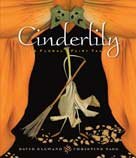
Book Review: CINDERLILLY
*NOTE: This book review was created for a class at TWU.
1. BIBLIOGRAPHY
Ellwand, David and Christine Tagg. CINDERLILLY. Cambridge, MA: Candlewick Press. ISBN 0763623288
2. PLOT SUMMARY
In this adaptation of the Cinderella story, the Sultan hold an Autumn Ball to choose his bride, the fairest bloom of them all. Predictably, Cinderlilly would like to attend, but is thwarted by her evil stepsisters. With the help of a fairy, Cinderlilly is magically transformed and enchants the Sultan. But, according to her spell, she must leave at midnight. As she runs away, a petal falls, leaving the only clue to her identity. After trying the petal on scores of flowers, the Sultan recognizes Cinderlilly and asks her to marry him. She put on the petal, magically becomes beautiful again, and marries the Sultan.
3. CRITICAL ANALYSIS
In the best cases, children's books incorporate text and illustrations which both complement and enrich each other while being outstanding on their own merits. In the worst cases, both illustrations and text are lacking. With CINDERLILLY, the reader gets a mixed bag.
The text, which is written in rhymed couplets, is an adaptation of the Cinderella story. Some aspects of the text are charming. For instance, I enjoyed that the text was written in Acts and kept many of the conventions of a ballet or stage performance, and I liked the way the font changed to highlight some of the words. However, strain of forcing the story into couplets shows in the meter. For instance, in the beginning of the story, we read, "Her name is CINDERLILLY,/and she's beautiful but shy./Forlorn and sad, she smoothes her petals-/she's trying not to cry." Metrically, the second and fourth lines should match up, but the second line has 7 beats, while the fourth only has 6. Such rhythmic awkwardness occurs often enough to cause the reader to stumble and have to reread lines.
In terms of plot, it appears that the story has been changed to suit the illustrations, but not consistently. The prince becomes a sultan, because, I presume, the petals used to make his breeches and his petal hat make him look Middle-Eastern. Yet, rather than listening to beautiful Persian melodies, the characters dance a waltz at a ball. Apart from the mention of the sultan, there are no other cultural trappings accompanying the plotline. It makes the change seem superfluous. Why couldn't he just have been a prince in petal pants?
The illustrations, on the other hand, created with real flower petals and other natural materials, such as fern fronds for trees, and manipulated using Adobe Photoshop are mesmerizing. The way David Ellwand uses the stamens to represent the characters' legs, replete with anther ballet slippers, is beautiful. Dark backgrounds throughout the book add to the three dimensional quality of the photographs. On the pages where Cinderlilly dances alone with broom, her legs and skirt petals have been so ingeniously placed that she literally seems to twirl across the page in her own private ballet. The dustcover notes mention that the poses are based on actual ballet and gymnastic steps, and the back page lists the names of the flowers used to create each character. It would be fun to plant a "Cinderlilly" garden to learn more about the flowers that went into the making of this book.
What the story lacks, the illustrations more than make up for, especially since most children know the Cinderella story by heart. CINDERLILLY would appeal to the gardener, ballet enthusiast, and fairytale lover alike.
4. REVIEW EXCERPT(S)
School Library Journal: " Tagg's text, written in reasonably well-rhymed couplets, is thin on plot, character development, and imagery."
Children's Literature: "...this innovative approach stimulates the reader to envision characters and the natural world in new ways. Children easily see the world as animate, and this story will draw them into the garden to find their favorite characters."
5. CONNECTIONS
*For older children studying PhotoShop in their digital graphics classes, CINDERLILLY and other children's stories which include illustration created in PhotoShop such as Don Woods' JUBAL'S WISH (ISBN 043916964S) and Richard Michelson's GRANPA'S GAMBLE(ISBN 0761450343). A good resource for discussing the artists' techniques is Carolyn Phelan's informative article from the December 2000 issue of Booklist, "COMPUTERS AND THE ART OF PICTURE BOOK ILLUSTRATION.," which can be accessed at www.booklistonline.com
*Compare with other variants of the Cinderella story. The best website I found that has reviews of many of these versions is Children's Literature's site at http://www.childrenslit.com/th_cinderella.html

No comments:
Post a Comment